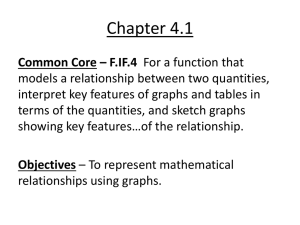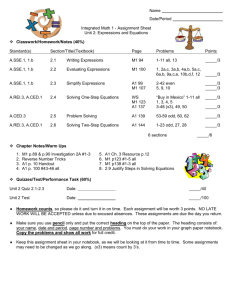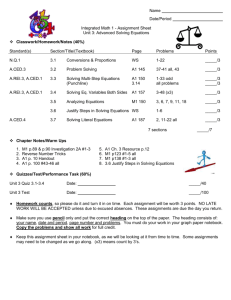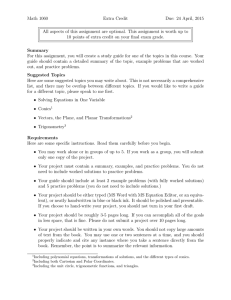College Preparatory Mathematics - CCSD Course Goals
advertisement
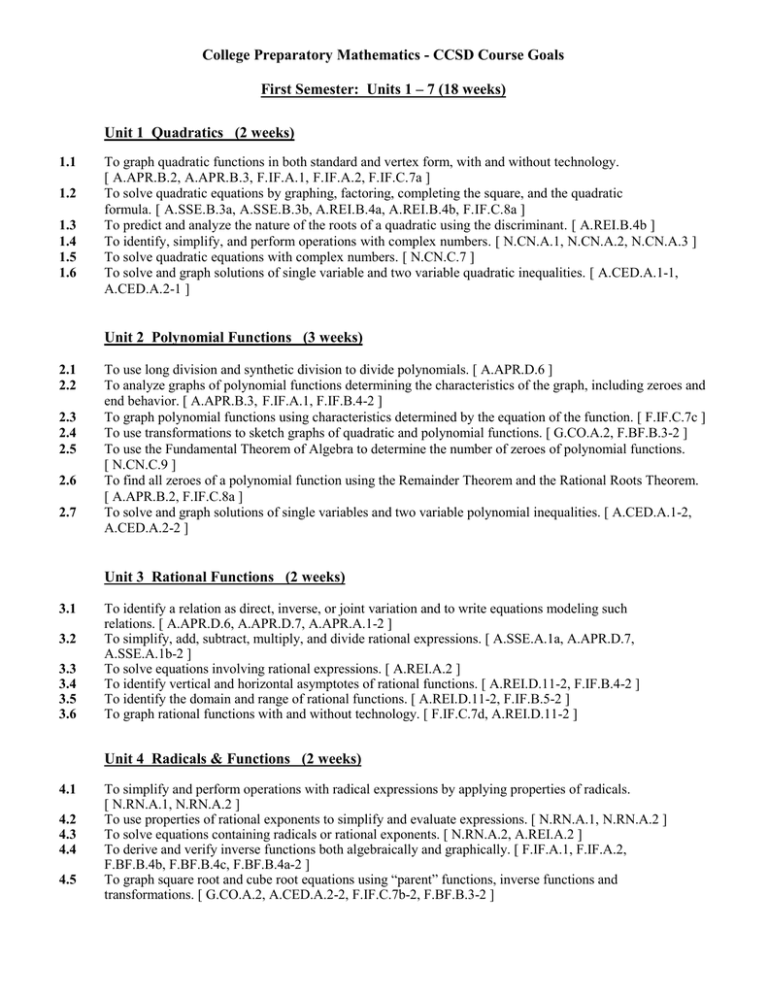
College Preparatory Mathematics - CCSD Course Goals First Semester: Units 1 – 7 (18 weeks) Unit 1 Quadratics (2 weeks) 1.1 1.2 1.3 1.4 1.5 1.6 To graph quadratic functions in both standard and vertex form, with and without technology. [ A.APR.B.2, A.APR.B.3, F.IF.A.1, F.IF.A.2, F.IF.C.7a ] To solve quadratic equations by graphing, factoring, completing the square, and the quadratic formula. [ A.SSE.B.3a, A.SSE.B.3b, A.REI.B.4a, A.REI.B.4b, F.IF.C.8a ] To predict and analyze the nature of the roots of a quadratic using the discriminant. [ A.REI.B.4b ] To identify, simplify, and perform operations with complex numbers. [ N.CN.A.1, N.CN.A.2, N.CN.A.3 ] To solve quadratic equations with complex numbers. [ N.CN.C.7 ] To solve and graph solutions of single variable and two variable quadratic inequalities. [ A.CED.A.1-1, A.CED.A.2-1 ] Unit 2 Polynomial Functions (3 weeks) 2.1 2.2 2.3 2.4 2.5 2.6 2.7 To use long division and synthetic division to divide polynomials. [ A.APR.D.6 ] To analyze graphs of polynomial functions determining the characteristics of the graph, including zeroes and end behavior. [ A.APR.B.3, F.IF.A.1, F.IF.B.4-2 ] To graph polynomial functions using characteristics determined by the equation of the function. [ F.IF.C.7c ] To use transformations to sketch graphs of quadratic and polynomial functions. [ G.CO.A.2, F.BF.B.3-2 ] To use the Fundamental Theorem of Algebra to determine the number of zeroes of polynomial functions. [ N.CN.C.9 ] To find all zeroes of a polynomial function using the Remainder Theorem and the Rational Roots Theorem. [ A.APR.B.2, F.IF.C.8a ] To solve and graph solutions of single variables and two variable polynomial inequalities. [ A.CED.A.1-2, A.CED.A.2-2 ] Unit 3 Rational Functions (2 weeks) 3.1 3.2 3.3 3.4 3.5 3.6 To identify a relation as direct, inverse, or joint variation and to write equations modeling such relations. [ A.APR.D.6, A.APR.D.7, A.APR.A.1-2 ] To simplify, add, subtract, multiply, and divide rational expressions. [ A.SSE.A.1a, A.APR.D.7, A.SSE.A.1b-2 ] To solve equations involving rational expressions. [ A.REI.A.2 ] To identify vertical and horizontal asymptotes of rational functions. [ A.REI.D.11-2, F.IF.B.4-2 ] To identify the domain and range of rational functions. [ A.REI.D.11-2, F.IF.B.5-2 ] To graph rational functions with and without technology. [ F.IF.C.7d, A.REI.D.11-2 ] Unit 4 Radicals & Functions (2 weeks) 4.1 4.2 4.3 4.4 4.5 To simplify and perform operations with radical expressions by applying properties of radicals. [ N.RN.A.1, N.RN.A.2 ] To use properties of rational exponents to simplify and evaluate expressions. [ N.RN.A.1, N.RN.A.2 ] To solve equations containing radicals or rational exponents. [ N.RN.A.2, A.REI.A.2 ] To derive and verify inverse functions both algebraically and graphically. [ F.IF.A.1, F.IF.A.2, F.BF.B.4b, F.BF.B.4c, F.BF.B.4a-2 ] To graph square root and cube root equations using “parent” functions, inverse functions and transformations. [ G.CO.A.2, A.CED.A.2-2, F.IF.C.7b-2, F.BF.B.3-2 ] Unit 5 Triangle Trigonometry & Vectors (2.5 weeks) 5.1 5.2 5.3 5.4 5.5 5.6 5.7 5.8 To write the six trigonometric functions in terms of the sides of a right triangle. [ G.SRT.C.6 ] To use the special right triangles to write trigonometric functions. [ G.SRT.C.8 ] To write a given angle in terms of its reference angle. [ G.SRT.C.7 ] To develop strategies for solving right triangles. [ G.SRT.C.8 ] To solve triangles using the law of sines and the law of cosines. [ G.SRT.D.10 ] To calculate the area of a triangle using A=1/2 ab sin C or Heron’s Formula. [ G.SRT.D.9 ] To solve real world applications involving trigonometric functions. [ G.SRT.D.11 ] To solve real world application problems using bearing and vectors. [ N.VM.A.1 ] Unit 6 Radians & Circle Trigonometry (3 weeks) 6.1 6.2 6.3 6.4 6.5 6.6 6.7 6.8 To distinguish between the radian measure and degree measure of an angle. [ F.TF.A.1 ] To establish a correspondence between points on the real number line and points on the unit circle by interrelating the wrapping (winding) process. [ F.TF.A.2 ] To determine values for the circular functions using the unit circle. [ F.TF.A.3 ] To describe graphical characteristics of the six trigonometric functions. [ F.TF.A.4 ] To sketch the graphs of the six trigonometric functions. [ F.TF.B.5 ] To graph transformations of the six trigonometric functions. [ F.TF.B.6 ] To solve real world applications of the basic trigonometric functions. [ F.TF.B.5 ] To model real world applications involving graphs of the trigonometric functions. [ F.TF.B.5 ] Unit 7 Identities & Trigonometric Equations (3 weeks) 7.1 7.2 7.3 7.4 7.5 7.6 To derive and apply the Pythagorean, co-function, quotient, reciprocal, sum and difference, double angle and half angle identities. [ F.TF.C.8 ] To evaluate expressions containing combinations and compositions of circular functions and their principal inverses. [ F.TF.B.7 ] To simplify trigonometric expressions. [ F.TF.C.8 ] To prove trigonometric identities. [ F.TF.C.9 ] To verify solutions using circular functions and their inverses. [ F.TF.B.7 ] To solve trigonometric equations. [ F.TF.B.7 ] Second Semester: Units 8 – 13 (18 weeks) Unit 8 Exponential & Logarithmic Functions (3 weeks) 8.1 8.2 8.3 8.4 8.5 8.6 To recognize and evaluate exponential and logarithmic expressions. [ A.SSE.A.2-2 ] To simplify and evaluate logarithmic expressions using the properties of logarithms and change of base. [ A.SSE.B.3c ] To solve exponential and logarithmic equations. [ A.SSE.B.3c, F.IF.C.8b, F.BF.B.5, F.BF.B.4a-2 ] To graph exponential and logarithmic functions with and without technology using “parent” functions and transformations. [ G.CO.A.2, A.REI.D.11-2, F.BF.B.3-2, F.IF.C.7e-2 ] To graph the inverse of an exponential or logarithmic function. [ F.IF.A.1, F.IF.A.2, F.BF.B.4b, F.BF.B.4c, F.BF.B.4a-2 ] To develop mathematical models using exponential and logarithmic functions to solve application problems. [ N.Q.A.1, N.Q.A.2, N.Q.A.3, F.IF.C.8b, F.LE.A.1a, F.LE.A.1b, F.LE.A.1c, F.LE.B.5, A.CED.A.1-2, F.IF.C.7b-2, F.IF.C.9-2, F.IF.C.7e-2 ] Unit 9 Matrices (2.5 weeks) 9.1 9.2 9.3 9.4 9.5 To define, add, subtract, scalar multiply, and multiply matrices. [ N.VM.C.7, N.VM.C.8, N.VM.C.9, N.VM.C.11 ] To find the determinant of a matrix with and without technology and to interpret the absolute value of the determinant in terms of area. [ N.VM.C.10, N.VM.C.12 ] To find inverse matrices with and without technology. [ A.REI.C.9 ] To use inverse matrices to solve systems of equations. [ A.REI.C.8, A.REI.C.9 ] To organize data into matrices to solve real world application problems using matrices. [ N.VM.C.6, A.REI.C.8, A.REI.C.9 ] Unit 10 Conics (3 weeks) 10.1 10.2 10.3 10.4 10.5 To define and identify the conic relations. [ A.REI.D.10, G.GMD.B.4 ] To put conic relation equations into standard form by completing the square. [ A.SSE.B.3b ] To graph conic relations both using center and vertices; and by using transformations. [ G.CO.A.2, A.CED.A.2-2, F.BF.B.3-2 ] To write equations of conic relations when given characteristics of their graphs. [ A.CED.A.2-2 ] To solve real world application problems using conic relations. [ N.Q.A.1, N.Q.A.2, N.Q.A.3, G.MG.A.1 ] Unit 11 Measures of Central Tendency & Variation (3 weeks) 11.1 11.2 11.3 11.4 11.5 11.6 11.7 11.8 11.9 To define and calculate measures of central tendencies (mean, median and mode). [ S.ID.A.2 ] To compare and contrast pros and cons of each measure of central tendency. [ S.ID.A.3 ] To define and calculate measures of variation (variance, standard deviation, range and interquartile range). [ S.ID.A.4 ] To graph frequency and relative frequency histograms. [ S.ID.B.5 ] To classify histogram shapes (uniform, bimodal, skewed right, etc.). [ S.ID.A.3 ] To calculate mean and standard deviation of grouped data [ S.ID.A.4 ] To compute the 5-number summary of a data set (low, Q1, median, Q3, high). [ S.IC.B.6 ] To graph and interpret box-and-whisker plots. [ S.IC.B.6 ] To consider effects of outliers. [ S.ID.A.3 ] Unit 12 Probability & Combinations (3 weeks) 12.1 12.2 12.3 12.4 12.5 To define and apply experimental, theoretical and empirical probabilities. [ S.CP.A.1 ] To calculate simple probabilities (P(roll a 7)), (P(draw an ace)). [ S.CP.A.2 ] To calculate compound probabilities (P(roll a 7 or an 11)), (P(roll a 7 and then an 11)), (P(draw a king or red)), (P(draw a queen then a king without replacement)). [ S.CP.A.3 ] To apply the multiplication rule of counting to determine the number of outcomes of an event. [ S.CP.B.9 ] To use the formulas for permutations and combinations to determine the number of outcomes of an event. [ S.CP.B.9 ] Unit 13 Binomial Probability & Residuals (3 weeks) 13.1 13.2 13.3 13.4 13.5 13.6 13.7 13.8 To graph discrete probability distributions. [ S.ID.A.1 ] To use probability distributions to compute simple probabilities. [ S.MD.A.1 ] To define and find the expected value of a probability distribution. [ S.MD.A.2 ] To define and use a binomial experiment to find binomial probabilities. [ S.MD.A.3 ] To find the mean and standard deviation of a binomial probability distribution. [ S.MD.A.2 ] To use scatter plots to find the line of best fit. [ S.ID.B.6c ] To interpret scatter plots and investigate positive or negative trends. [ S.ID.B.6c ] To determine the residual of a scatter plot. [ S.ID.B.6b ]
